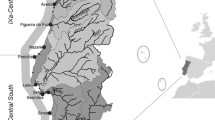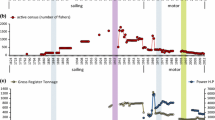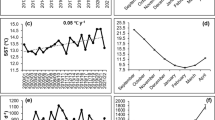Abstract
The variability of coastal marine resources has been linked to environmental variability but the impacts of artisanal nearshore fishing activity and environmental factors interact in different ways. Time series, Min/Max Autocorrelation Factor, Generalised Least Squares and Dynamic Factor Analyses models were applied to examine the role of environmental factors (SST, NAO Index, Upwelling Index, Wind Magnitude, Easterly Wind Component, Northerly Wind Component, Coastal River Discharges) and fisheries effort on commercial catch rates of Diplodus vulgaris in the Northwest, Southwest and South Portuguese coast. Environmental factors were found to affect short-term variations of catch rates with a time lag of 2 years, according to the regions and seasons. In the Northwest, autumn wind magnitude and summer river discharges were positively correlated with D. vulgaris catch rates. In the Southwest, D. vulgaris catch rates were negatively associated with variations in winter sea surface temperature. In the South, catch rates were positively associated with yearly westerly wind component and yearly, winter and autumn river discharges whilst negatively associated with the North Atlantic Oscillation (NAO) Index. These results indicate that both large-scale climatic patterns and local hydrological factors can have an influential role in determining the abundance of D. vulgaris stocks. Fishery assessment should therefore incorporate information on ecosystem and environmental effects to help managers to make informed decisions on how to best regulate coastal fisheries.




Similar content being viewed by others
References
Agostini, V.N., and A. Bakun. 2002. ‘Ocean triads’ in the Mediterranean Sea: physical mechanisms potentially structuring reproductive habitat suitability (with example application to European anchovy, Engraulis encrasicolus). Fisheries Oceanography 11(3): 129–142.
Atlas, R., R.N. Hoffman, J. Ardizzone, S.M. Leidner, J.C. Jusem, D.K. Smith, and D. Gombos. 2011. A cross-calibrated, multiplatform ocean surface wind velocity product for meteorological and oceanographic applications. Bulletin of the American Meteorological Society 92: 157–174.
Bailey, K.M., and E.D. Houde. 1989. Predation on eggs and larvae of marine fishes and the recruitment problem. Advances in Marine Biology 25: 1–83.
Bakun, A. 1985. Comparative studies and the recruitment problem: searching for generalizations. California Cooperative Fisheries Investigations Reports 26: 30–40.
Baptista, V., and F. Leitão. 2014. Commercial catch rates of Spisula solida reflect local environmental conditions on the coast of Portugal. Journal of Marine Systems 130: 79–89.
Baptista, V., H. Ullah, C.M. Teixeira, P. Range, K. Erzini, and F. Leitão. 2014. Influence of environmental variables and fishing pressure on bivalve fisheries in an inshore lagoon and adjacent nearshore coastal area. Estuaries and Coasts 37(1): 191–205.
Bauchot, M.L., and J.C. Hureau. 1986. Sparidae. In Fishes of the North-eastern Atlantic and the Mediterranean, II, ed. P.J.P. Whitehead, M.L. Bauchot, J.C. Hureau, J. Nielsen, and E. Tortonese, 883–907. Paris: UNESCO.
Borges, M.F., A.M.P. Santos, N. Crato, H. Mendes, and B. Mota. 2003. Sardine regime shifts off Portugal: a time series analysis of catches and wind conditions. Scientia Marina 67(1): 235–244.
Borges, R., R. Ben-Hamadou, M.A. Chícharo, P. Ré, and E.J. Gonçalves. 2007. Horizontal spatial and temporal distribution patterns of nearshore larval fish assemblages at a temperate rocky shore. Estuarine, Coastal and Shelf Science 71: 412–428.
Brander, K.M. 2007. Global fish production and climate change. Proceedings of the National Academy of Sciences of the United States of America 104(50): 19709–19714.
Brander, K.M. 2010. Impacts of climate change on fisheries. Journal of Marine Systems 79: 389–402.
Burnham, K.P., and D.R. Anderson. 1998. Model selection and multimodel inference: a practical information-theoretic approach. USA: Springer.
Cunha, M.E. 2001. Physical control of biological processes in a coastal upwelling system: comparison of the effects of coastal topography, river run-off and physical oceanography in the northern and southern parts of western Portuguese coastal waters. PhD Thesis, Faculdade de Ciência da Universidade de Lisboa, 305 pp.
Cury, P., and C. Roy. 1989. Optimal environmental window and pelagic fish recruitment success in upwelling areas. Canadian Journal of Fisheries and Aquatic Sciences 46: 670–680.
Cushing, D.H. 1996. Towards a science of recruitment in fish populations. Excellence in ecology. Oldendorf: Ecology Institute.
DGRM, 2012. Recursos da Pesca. Série Estatística 2012. Direcção-Geral de Recurscos Naturais, Segurança e Serviços Marítimos, Vol. 25 A-B, 192pp.
Erzini, K. 2005. Trends in NE Atlantic landings (southern Portugal): identifying the relative importance of fisheries and environmental variables. Fisheries Oceanography 14(3): 195–209.
Erzini, K., J. Gonçalves, L. Bentes, P.G. Lino, J. Ribeiro, and K.I. Stergiou. 2003. Quantifying the roles of competing static gears: comparative selectivity of longlines and monofilament gill nets in a multi-species fishery of the Algarve (southern Portugal). Scientia Marina 67(3): 341–352.
Fernández, E., J. Cabal, J.L. Acuña, A. Bode, A. Botas, and C. García-Soto. 1993. Plankton distribution across a slope current-induced front in the southern Bay of Biscay. Journal of Plankton Research 15: 619–641.
Fiúza, A.F.G. 1983. Upwelling patterns off Portugal. In Coastal upwelling: its sediment record, ed. E. Suess and J. Thiede, 85–98. New York: Plenum Publishing.
Fréon, P., C. Mullon, and G. Pichon. 1993. CLIMPROD: experimental interactive software for choosing and fitting surplus production models including environmental variables. FAO Computerized Information Series (Fisheries). Rome: FAO.
García-Rubies, A., and E. Macpherson. 1995. Substrate use and temporal pattern of recruitment in juvenile fishes of the Mediterranean littoral. Marine Biology 124: 35–42.
Gonçalves, J.M.S., and K. Erzini. 2000. The reproductive biology of the two-banded sea bream (Diplodus vulgaris) from the SW coast of Portugal. Journal of Applied Ichthyology 16(3): 110–116.
Gonçalves, J.M.S., L. Bentes, R. Coelho, C. Correia, P.G. Lino, C.C. Monteiro, J. Ribeiro, and K. Erzini. 2003. Age and growth, maturity, mortality and yield-per-recruit for two banded bream (Diplodus vulgaris Geoffr.) from the south coast of Portugal. Fisheries Research 62: 349–359.
Gröger, J.P., and M.J. Fogarty. 2011. Broad-scale climate influences on cod (Gadus morhua) recruitment on Georges Bank. ICES Journal of Marine Science. doi:10.1093/icesjms/fsq196.
Harmelin-Vivien, M.L., J.G. Harmelin, and V. Leboulleux. 1995. Microhabitat requirements for settlement of juvenile sparid fishes on Mediterranean rocky shores. Hydrobiologia 301: 309–320.
Herraiz, I.G., M.A. Torres, A.C. Farina, J. Freirec, and J.R. Cancelo. 2009. The NAO index and the long-term variability of Nephrops norvegicus population and fishery off West of Ireland. Fisheries Research 98: 1–7.
Houde, E.D. 1987. Fish early life dynamics and recruitment variability. American Fisheries Society Symposium 2: 17–29.
Hurrell, J.W. 1995. Decadal trends in the North Atlantic Oscillation: regional temperatures and precipitation. Science 269: 676–679.
ICES. 2010. Report of the Working Group on Assessment of New MoU Species (WGNEW), 11–15 October 2010, ICES HQ, Denmark. ICES CM 2010/ACOM: 21.
IPCC. 2001. Climate Change 2001: synthesis report. A contribution of Working Groups I, II and III to the Third Assessment Report of the Intergovernmental Panel on Climate Change. Cambridge: Cambridge University Press.
Keyl, F., and M. Wolff. 2008. Environmental and fisheries: what can models do? Reviews in Fish Biology and Fisheries 18: 273–299.
Landaeta, M.F., and L.R. Castro. 2002. Spring spawning and early nursery zone of the esopelagic fish Maurolicus parvipinnis at the coastal upwelling zone off Talcahuano, central Chile. Marine Ecology Progress Series 226: 179–191.
Lasker, R. 1978. The relation between oceanographic conditions and larval anchovy food in the California Current: identification of the factors leading to recruitment failure. Rapports et Proces-verbaux des Réunions. Conseil International pour l'Éxploration de la Mer 173: 212–230.
Lehodey, P., J. Alheit, M. Barange, T. Baumgartner, G. Beaugrand, K. Drinkwater, J.-M. Frontentin, S.R. Hare, G. Ottersen, R.I. Perry, C. Roy, C.D. van der Lingen, and F. Werner. 2006. Climate variability, fish and fisheries. Journal of Climate 19: 5009–5030.
Leitão, F., M.N. Santos, K. Erzini, and C.C. Monteiro. 2009. Diplodus spp. assemblages on artificial reefs: importance for near shore fisheries. Fisheries Management and Ecology 16: 88–99.
Leitão, F., V. Alms, and K. Erzini. 2014a. A multi-model approach to evaluate the role of environmental variability and fishing pressure in sardine fisheries. Journal of Marine Systems 139: 128–138.
Leitão, F., V. Baptista, D. Zeller, and K. Erzini. 2014b. Reconstructed catches and trends for mainland Portugal fisheries between 1938 and 2009: implications for sustainability, domestic fish supply and imports. Fisheries Research 155: 33–50.
Lloret, J., J. Lleonart, I. Solé, and J.-M. Fromentin. 2001. Fluctuations of landing and environmental conditions in the north western Mediterranean Sea. Fisheries Oceanography 10(1): 33–50.
Loots, C., S. Vaz, B. Planque, and P. Koubbi. 2011. Understanding what controls the spawning distribution of North Sea whiting (Merlangius merlangus) using a multi‐model approach. Fisheries Oceanography 20: 18–31.
Moita, I. 1986. Plataforma continental. Carta dos sedimentos superficiais. Notícia explicativa da folha SED 7 e 8. Lisboa: Instituto Hidrográfico.
Morales-Nin, B., A.M. Grau, and M. Palmer. 2010. Managing coastal zone fisheries: a Mediterranean case study. Ocean and Coastal Management 53: 99–106.
Ottersen, G., B. Planque, A. Belgrano, E. Post, P.C. Reid, and N.C. Stenseth. 2001. Ecological effects of the North Atlantic Oscillation. Oecologia 128: 1–14.
Parrish, R.H., C.S. Nelson, and A. Bakun. 1981. Transport mechanisms and reproductive success of fishes in the California current. Biological Oceanography 1(2): 175–204.
Pinheiro, J.C., and D.M. Bates. 2000. Mixed-effects models in S and S-PLUS. Germany: Springer.
Planes, S., and P. Lenfant. 2002. Temporal change in the genetic structure between and within cohorts of a marine fish, Diplodus sargus, induced by a large variance in individual reproductive success. Molecular Ecology 11: 1515–1524.
Planque, B., and T. Frédou. 1999. Temperature and the recruitment of Atlantic cod (Gadus morhua). Canadian Journal of Fisheries and Aquatic Sciences 56: 2069–2077.
Planque, B., C. Loots, P. Petitgas, U. Lindstrøm, and S. Vaz. 2011. Understanding what controls the spatial distribution of fish populations using a multi-model approach. Fisheries Oceanography 20(1): 1–17.
Relvas, P., J. Luis, and A.M.P. Santos. 2009. The importance of the mesoscale in the decadal changes observed in the Northern Canary upwelling system. Geophysical Research Letters 36, L22601. doi:10.1029/2009GL040504.
Santos, F.D., and P. Miranda. 2006. Alterações Climáticas em Portugal: Cenários, Impactos e Medidas de Adaptação. Projecto SIAM II. Lisboa: Publicações Gravida.
Santos, A.M.P., M.F. Borger, and S. Groom. 2001. Sardine and horse mackerel recruitment and upwelling off Portugal. ICES Journal of Marine Science 58: 589–596.
Solow, A.R. 1994. Detecting changes in the composition of a multispecies community. Biometrics 50(2): 556–565.
Solow, A.R. 2002. Fisheries recruitment and the North Atlantic Oscillation. Fisheries Research 54(2): 295–297.
Tanaka, M. 1985. Factors affecting the inshore migration of pelagic larval and demersal juvenile red sea bream Pagrus major to a nursery ground. Transactions of the American Fisheries Society 114: 471–477.
Teixeira, C.M., R. Gamito, F. Leitão, H.N. Cabral, K. Erzini, and M.J. Costa. 2014. Trends in landings of fish species potentially affected by climate changes in Portuguese fisheries. Regional Environmental Change 14: 657–669.
Ullah, H., F. Leitão, V. Baptista, and L. Chicharo. 2012. An analysis of the impacts of climatic variability and hydrology on the coastal fisheries, Engraulis encrasicolus and Sepia officinalis, of Portugal. Ecohydrology and Hydrology 12(4): 337–352.
Vinagre, C., F.D. Santos, H.N. Cabral, and M.J. Costa. 2009. Impact of climate and hydrology on juvenile fish recruitment towards estuarine nursery grounds in the context of climate change. Estuarine, Coastal and Shelf Science 85: 479–486.
Vinagre, C., H.N. Cabral, and M.J. Costa. 2010. Relative importance of estuarine nurseries for species of the genus Diplodus (Sparidae) along the Portuguese coast. Estuarine, Coastal and Shelf Science 86: 197–202.
Zuur, A.F., R.J. Frywe, I.T. Jolliffe, R. Dekker, and J.J. Beukema. 2003a. Estimating common trends in multivariate time series using dynamic factor analysis. Environmetrics 15: 665–668.
Zuur, A.F., I.D. Tuck, and N. Bailey. 2003b. Dynamic factor analysis to estimate common trends in fisheries time series. Canadian Journal of Fisheries and Aquatic Sciences 60: 542–552.
Zuur, A.F., E.N. Ieno, and G.M. Smith. 2007. Analysing ecological data. USA: Springer.
Zuur, A.F., E.N. Ieno, and C.S. Elphick. 2010. A protocol for data exploration to avoid common statistical problems. Methods in Ecology and Evolution 1: 3–14.
Acknowledgments
The authors are grateful to Carlos Moura (DGRM) for providing fisheries data and to ARH-Algarve for providing river discharge data. F. Leitão and V. Baptista hold scholarships from Fundação para a Ciência e Tecnologia (references SFRH/BPD/63935/2009 and SFRH/BD/104209/2014, respectively).
Author information
Authors and Affiliations
Corresponding author
Additional information
Communicated by Karin Limburg
Appendix
Appendix
Rights and permissions
About this article
Cite this article
Baptista, V., Campos, C.J.A. & Leitão, F. The Influence of Environmental Factors and Fishing Pressure on Catch Rates of Diplodus vulgaris . Estuaries and Coasts 39, 258–272 (2016). https://doi.org/10.1007/s12237-015-9990-y
Received:
Revised:
Accepted:
Published:
Issue Date:
DOI: https://doi.org/10.1007/s12237-015-9990-y




